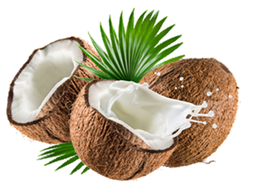
Coconut Wax Specification and Safety Information
DESCRIPTION
SOLVEN COCONUT WAX is a white, rigid wax with an exceptional consistency and composed of 100% hydrogenated coconut and palm kernel vegetable wax.
PROPERTIES
See the tests, specification, Solven method and reference method in the PDF file available for download.
APPLICATION / MAIN USES
SOLVEN COCONUT WAX (COCONUT WAX) is mainly used in the manufacture of handmade candles, commonly packaged in glass and metal pots and cups.
PACKAGING, STORAGE AND HANDLING
Product available in boxes containing 5 5kg tablets, 15kg buckets, 1.5kg pots. It must be kept away from sources of ignition, in a cool, dry place, protected from the weather. The shelf life of this product is 36 months from the date of manufacture, under the recommended storage conditions and/or original packaging.
CLASSIFICATION FOR TRANSPORT
This product is not classified as hazardous according to current legislation.
STORAGE
Keep preferably in places free from sunlight. Provide good room ventilation at room temperature and atmospheric pressure. Keep in a dry environment, away from heat, oxidants and strong sources of ignition.
PHYSICAL AND CHEMICAL PROPERTIES
Aspect:
- Physical-Solid state at room temperature;
- Color white.
Smell: Characteristic.
pH: Not applicable.
Melting Point: 50 to 54ºC (ASTM Method D-87).
Flash Point: Min. 200°C (ASTM Method D-92).
Solubility in water: Insoluble.
STABILITY AND REACTIVITY
Stability: Stable.
Hazardous Reactions: Keep away from strong chemical oxidizers (eg peroxides, nitric acid, concentrated sulfuric acid), halogenated hydrocarbons, alkali hydroxides, halogens, ethane amines, alkali metals, nitrous compounds. Reacts with many plastic materials.
Conditions to avoid: Sources of heat and ignition.
TOXICOLOGICAL INFORMATION
Acute Toxicity: In high concentrations of smoke, it can cause nausea, headache, dizziness and anesthetic effects.
- Inhalation: When inhaled, fumes cause mucosal irritation. In high concentrations, inhaled vapors have a narcotic and anesthetic effect, and can cause headache, dizziness, nausea, drowsiness, malaise and loss of consciousness. In solid state it is inert;
- Skin Contact: Associated with other chemical components, it may cause irritation due to hypersensitivity;
- Eye Contact: Negligible;
- Ingestion: No records found;
- Specific effects: As it is a solid product, other effects, other than the skin, only occur in cases of production of vapors due to abnormal heating. In liquid state, avoid contact with eyes and skin, due to risk of burns.
ECOLOGICAL INFORMATION
Mobility: Non-Volatile.
Environmental impact: In normal state it does not cause damage to the atmosphere.
Ecotoxicity: Effects on aquatic organisms – given its chemical inertness characteristics, low solubility, it is not liable to harm life. Effects on soil organisms – not likely to cause soil damage.
CONSIDERATIONS ON FINAL DESTINATION
Treatment and disposal methods:
- Product: the treatment and disposal of the product must be technically evaluated on a case-by-case basis;
- Product waste: Dispose of properly according to local legislation. Incineration or kiln processing are suitable methods for disposal;
- Contaminated packaging: empty packaging must be cleaned before recycling or final disposal at an authorized facility. Do not reuse empty packaging.